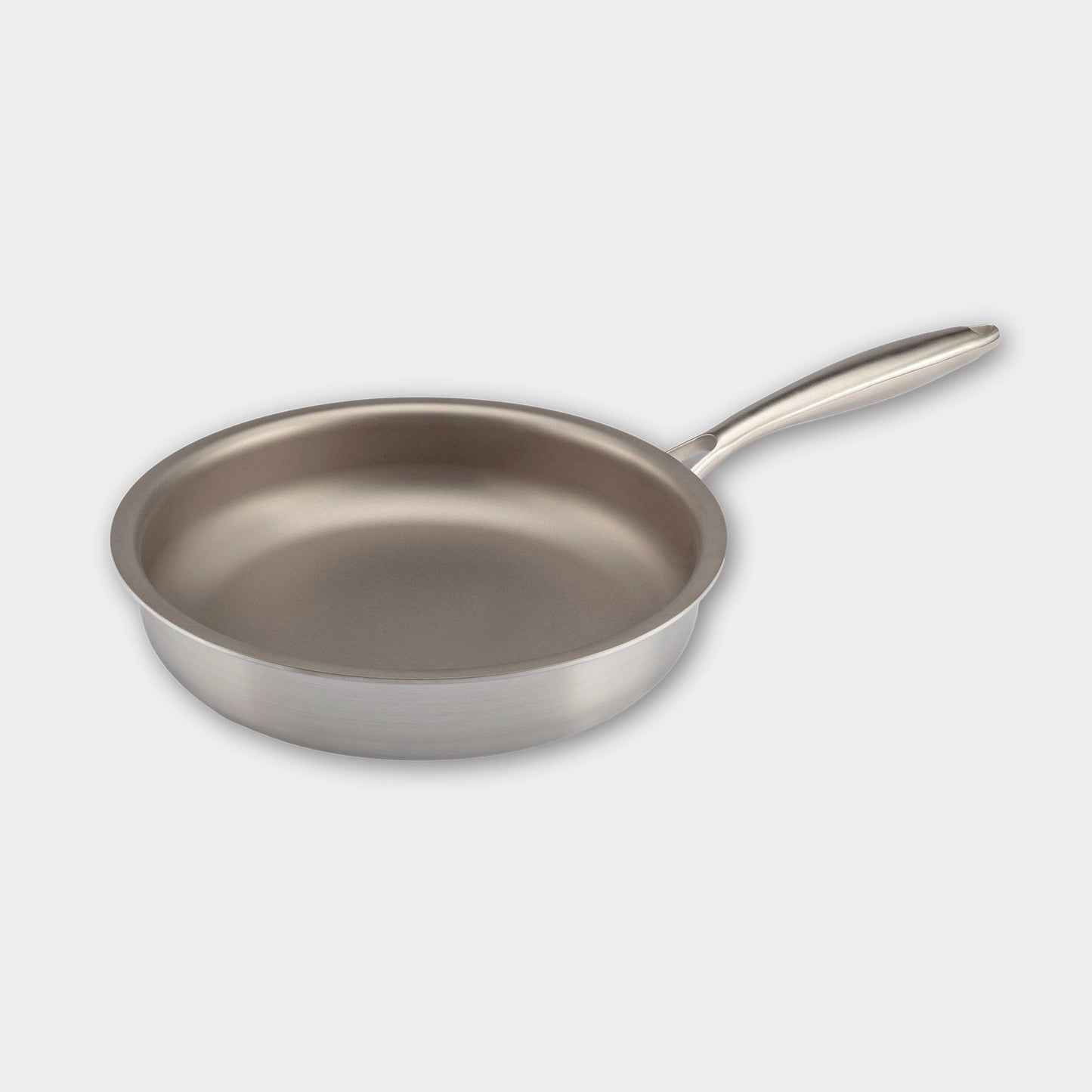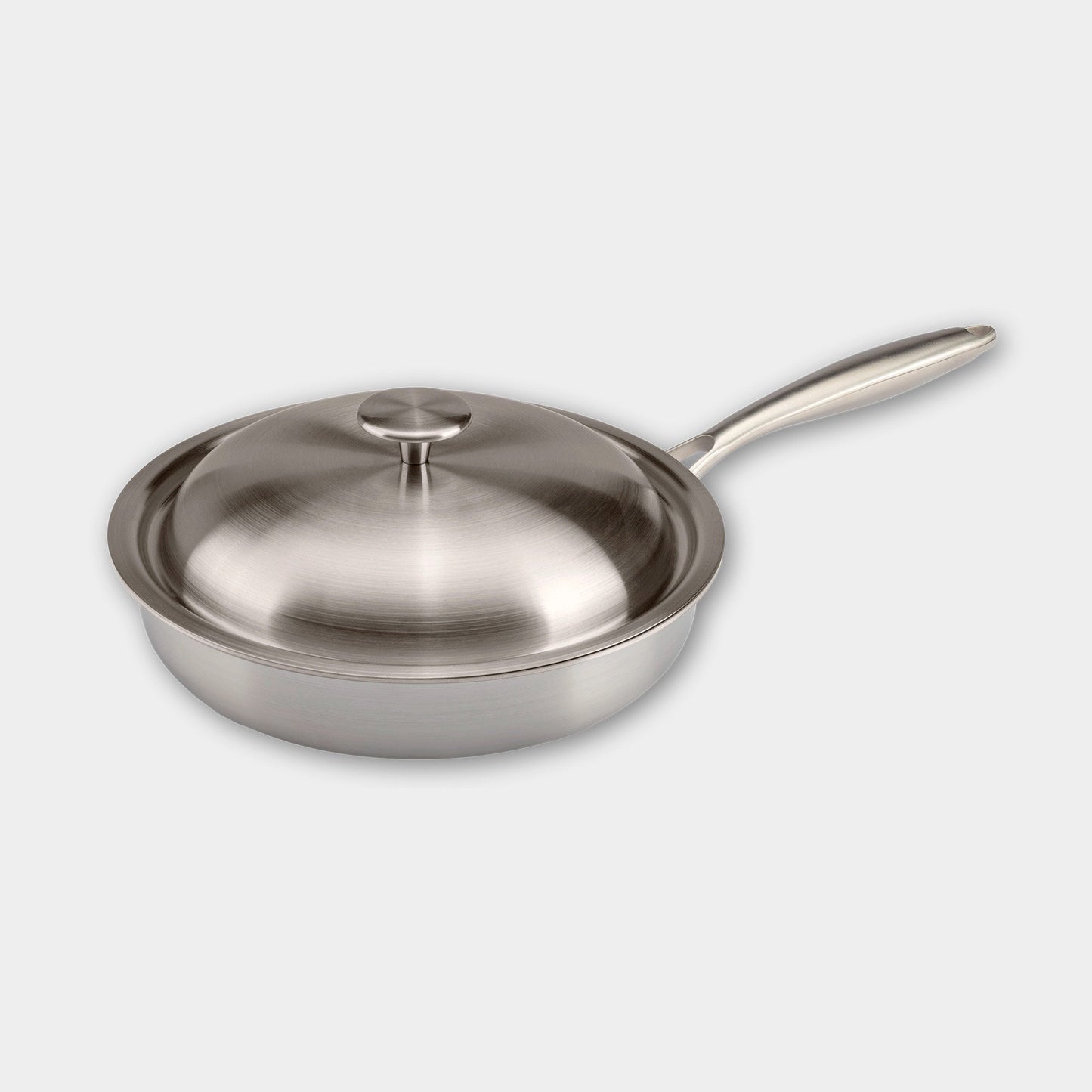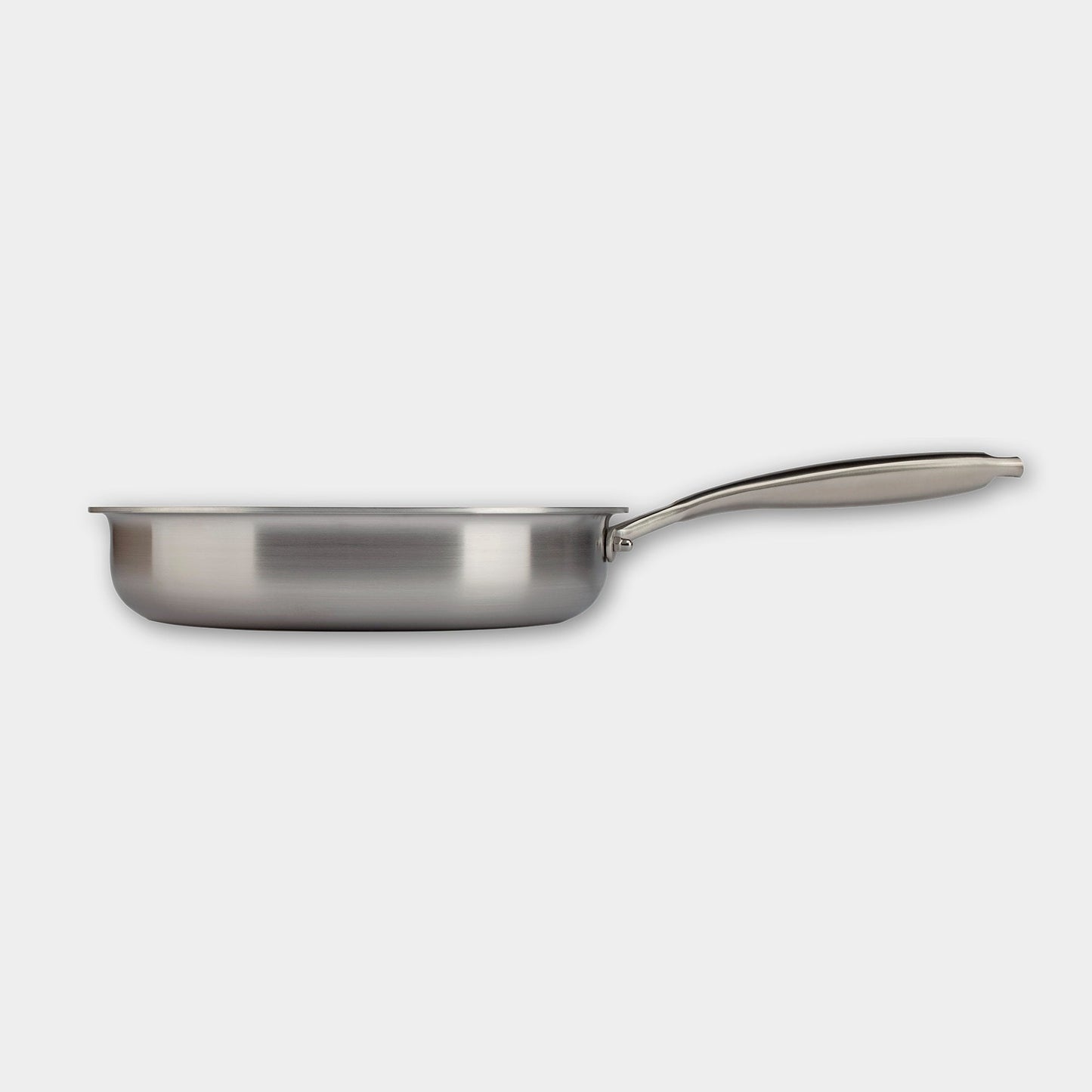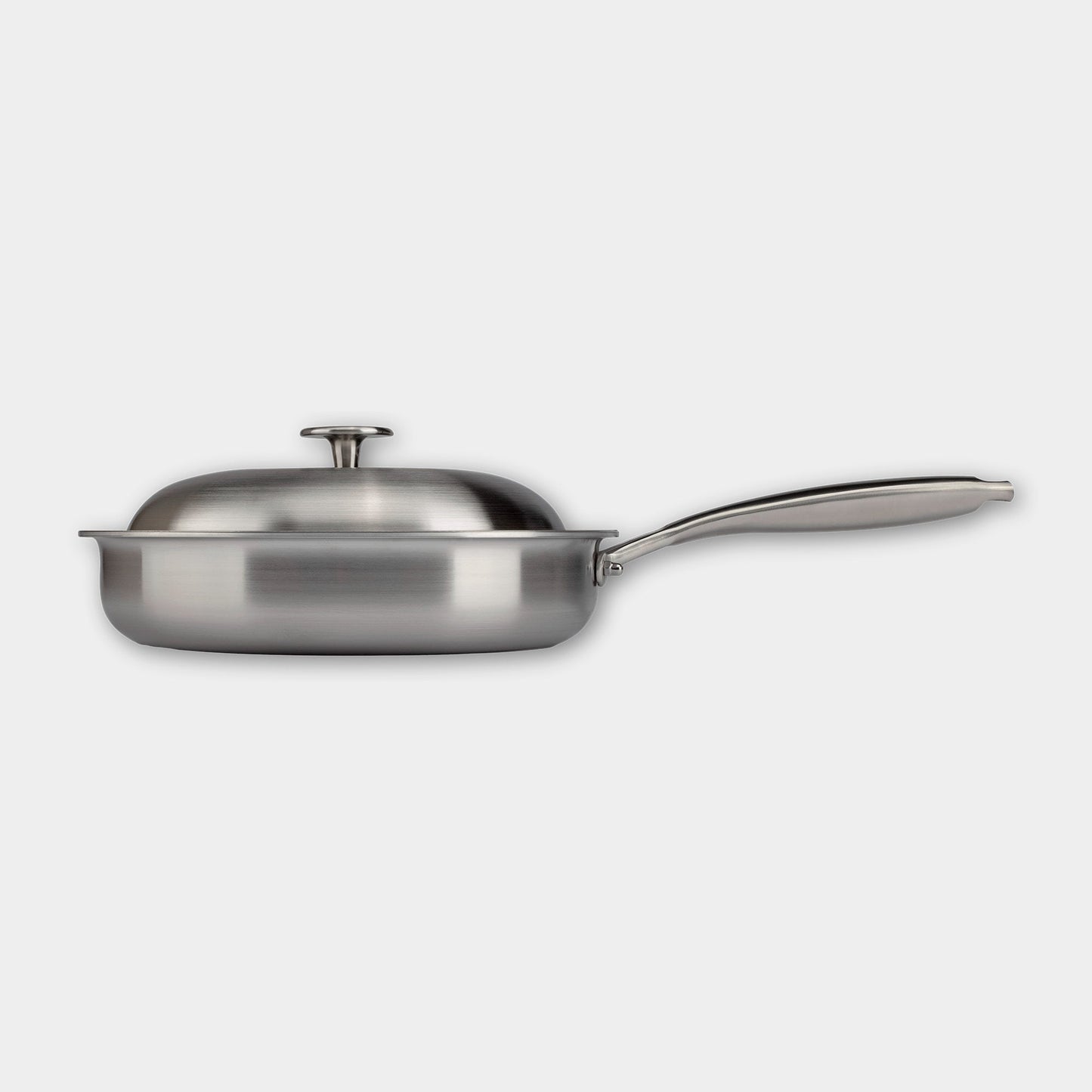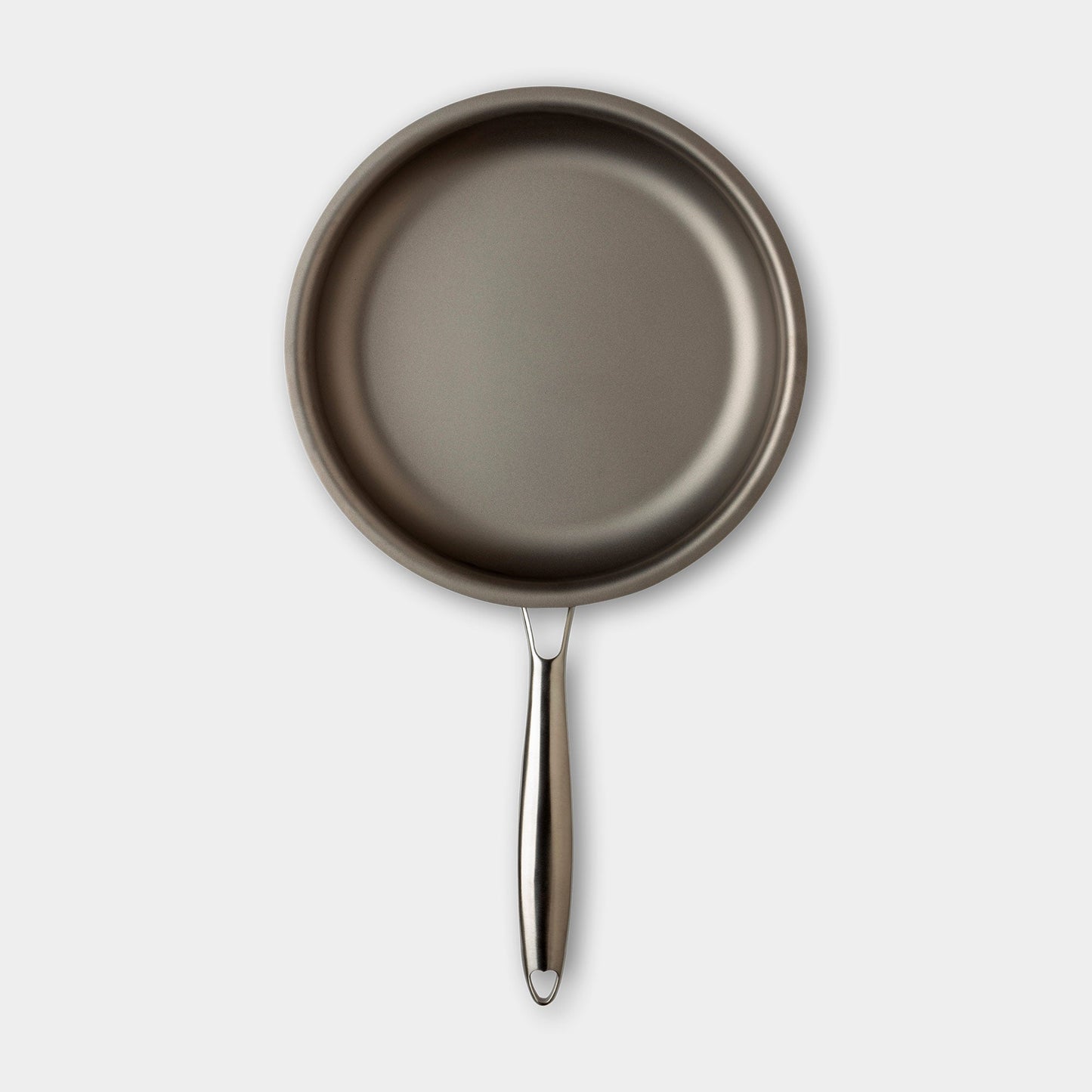This site is protected by hCaptcha and the hCaptcha Privacy Policy and Terms of Service apply.
Elevate Your Wellbeing with Our Revolutionary ZERO-TOXIC Cooking Tool (Not Just a Pan!)
Forget traditional cookware! ZERO-TOXIC isn't just a pan; it's an investment in your health, whether you have metal allergies (like nickel) or simply prioritize healthy eating.
Here's what sets it apart:
Solid Titanium Cooking Surface (Not Coated): Ensures unmatched safety for you and the environment.
Non-Toxic, Biocompatible, and Eco-Friendly: Releases no harmful substances while cooking, preserving food's natural flavors.
Versatile for Everyday Cooking: Perfect for grilling steaks, stir-frying vegetables, simmering stews, making fluffy omelets, or whipping up crispy fries.
Professional-Grade Multi-Layered Construction: Combines AISI 430 stainless steel for the exterior, aluminum for optimal heat distribution, and pure titanium for the cooking surface.
Ergonomic Long Handle: Stays cool for comfortable handling throughout cooking.
Slightly Domed Nickel-Free Steel Lid: Traps steam and maximizes capacity.
Our Commitment:
Peace of Mind, Allergy-Free Cooking: No non-stick coatings, nickel, or other potentially harmful substances. Resists acidic and alkaline ingredients, high temperatures, and won't release harmful fumes.
Sustainable Choice: Titanium is a natural, recyclable material with minimal environmental impact.
Superior Performance: Ensures even heat distribution, boasts a gentle slight natural non-stick effect, and promotes healthy low-fat cooking.
Built to Last: Resists scratches, flaking, and high temperatures for long-lasting durability.
Unmatched Comfort: Features a well-balanced, lightweight design with ergonomic, heat-resistant handles.
Energy Efficiency: Offers superior temperature control and high thermal efficiency for optimal cooking results.
Investing in your well-being doesn't stop at your food.
ZERO-TOXIC is professional-grade pan that requires a little more attention. Don't leave it unattended on the stove while you multitask.
Experience the ZERO-TOXIC difference and discover a whole new way to cook!
TECHNICAL FEATURES
- Color: matte silver
- Technology: single-body, multilayer
- Material: Titanium (cooking surface)- Aluminium (inner layer) - AISI 430 Stainless steel (outer layer)
- Width: 0.12" (Steel: 0,6 mm, Aluminum 1,9 mm, Titanium: 0,5 mm)
- Surface finish: external satin-finishing and internal sandblasting
- Handle: long handle, made of hollow satin stainless steel, screwed on the outside, without internal rivets
- Lid: Stainless Steel AISI 430, nickel free
- Height: 1.96"
- Sides: flared
- Pan Weight: 2.42 lb
- Lid Weight: 1.10 lb
- Spilling board: yes
- Heat sources: gas stove - induction - oven - ceramic
- Metal tool proof: yes
- Dishwasher safe: yes
- Number of pieces: 1 pan + 1 lid
USE ZERO-TOXIC TO ITS FULLEST POTENTIAL
THE IMPORTANCE OF THE HEATING PHASE
What does this mean in practice? It means that we have to respect some basic guidelines, especially when we cook non-moist food in a ZERO-TOXIC pan and if we want to limit the use of seasoning (or even not use it at all)
Here they are
- Be patient while heating: if in fact we put food in the pan (steak, eggs) when it is not yet hot enough, it is likely to stick to the surface.
- Always cook food with low flame, in some cases (short cooking) we can even think of using the heat reflected by the lid and finish cooking with the fire off. Don't think that keeping the flame high will shorten the cooking time! This will not happen and instead we risk having the food stick to the bottom of the pan.
- In the final stages of 'wet' cooking, when we want the sauce to shrink or the broth to evaporate completely, we can raise the temperature a little. In this delicate phase you will have to carefully supervise the cooking process by lowering the flame again if necessary and by occasionally stirring the food with a spatula.
MAKE THE MOST OF THE NATURAL NON-STICK PROPERTIES OF TITANIUM
Titanium benefits from a certain natural non-stickness: it is not comparable to that of non-stick cooking units, but it is still superior to that of other metals.
This feature also increases with use, so we recommend using ZERO-TOXIC cooking units initially for cooking moist food (stewed vegetables or meat) or with a normal amount of seasoning.
After this "break-in" phase, you can move on to cooking with little fat, always remembering to cook over moderate or low heat: by wisely dosing the temperature you will avoid the food from sticking and it will be very easy to clean the pans after cooking.

COOKING STEAK
Some cuts of meat are more suitable than others for the preparation of a good grilled steak without seasoning: sirloin is certainly one of them, because it associates flavor and tenderness to an adequate fat content. In this way it will be possible to avoid adding seasoning, which, by overheating, could alter the flavor of the meat. We recommend a slightly fatty cut with an adequate thickness (2 cm).
Metal is the ideal material to trigger the Maillard reaction. You know what I'm talking about right? It is the chemical reaction that takes place at temperatures between 140°C and 180°C, between the amino acids of proteins and sugars and gives rise to a beautiful brown color and that typical taste of 'roasted meat'. Titanium, thanks to its slight non-stick properties, will give you a hand in obtaining an excellent result.
Not all meats can easily trigger the Maillard reaction: beef contains the right quantity of sugars to develop this reaction, whereas in order to promote the caramelization of white meats (chicken, veal, pork) it is necessary to marinate them (with olive oil and spices) and eventually add wine or lemon or honey while cooking.
Let's see how to get a nicely browned steak with a ZERO-TOXIC pan:
- You will need to have the patience to heat the pan over high heat for a long time (about 4 minutes) to reach the right temperature
- After this time, place the steak, if possible at room temperature and well dried (wiped with paper towels) on the bottom of the pan and cook it without touching it until it comes off on its own. Only when you lift a flap you will see that it has reached a nice brown color you can turn it.
- During cooking it is necessary to wisely dose the heat ( if necessary lowering the flame) because the temperature must be kept constant.
Tip: if you only need to cook one steak you can use the 24 cm. pan; for two good steaks use the 26 or 30. In any case, we recommend that you do not overfill the pan: you will prevent the temperature from dropping too low and the water that will come out of the steaks will accumulate on the bottom, preventing the Maillard reaction from being triggered. If this happens, in fact, you will get sad-looking steaks: moist outside and dry inside, pale and hard!

COOKING EGGS
In case you want to cook an omelette or fried eggs, once again the secret lies in the correct temperature setting both when heating the pan and during cooking.
- Let's look at fried eggs.
- Oil and butter lovers are divided on the right fat to use when cooking eggs. We recommend using a mix of both to prevent the butter from turning black.
- Heat it slowly over moderate heat, moving the pan so that it is evenly distributed (or using a bit of household paper for this purpose) . Only when the seasoning begins to ripple and sizzle slightly, place the eggs in the pan: if they open first, there is a risk of the egg white sticking to the bottom of the pan; if they open too late, there is a risk of burning them on the outside.
- Cook the eggs for just long enough for the egg white to set and the yolk to compact slightly on the bottom while remaining soft and creamy on top (about 4-5 minutes).
- However, if you want the egg white to be firm and the yolk to be almost liquid, add the egg white first, continue cooking for a while and then add the yolk.
- Add salt (only on the egg whites) and if necessary pepper and serve.
MILANESE RISOTTO
Risotto alla Milanese - yellow rice with saffron - is an internationally symbolic dish of the Lombardy tradition. There is a codified recipe for this dish, approved and deposited at the City of Milan with a special ruling that gives it the status of De.Co.: Denominazione Comunale ("Communal Denomination"). It requires the inclusion of the following ingredients: beef marrow, roast beef fat, chopped onion and butter (for the sauté), concentrated meat broth for cooking the rice, saffron (in pistils), aged Grana Padano cheese and butter for the creaming. Wine is not included.
We can obviously consider unorthodox recipes, but healthier and more digestible (with less fat) as well as delicate in taste, avoiding the use of marrow and roast fat, using a mix of butter and oil for the sauté and possibly using a vegetable broth.
As for rice varieties, nowadays Carnaroli is the most popular, but we suggest to take into consideration Vialone Nano, IGP, with a smaller grain, excellent cooking properties, high amylose content, therefore perfect for Risotto all'Onda.
The ZERO-TOXIC low casserole is perfect for cooking risotto, because it ensures uniform cooking and in no way alters the flavor of a food as delicate as rice. You can use the 26cm casserole for 3-4 servings and the 30cm casserole for 6-8 servings.
Finely chop the onion and place it in the saucepan together with a little oil and a small knob of butter, sauté slowly until it turns golden brown and add the rice (two fistfuls per person). Toast the rice for a few minutes over moderate heat to prevent it from burning: at this stage you can stir the rice with a spatula. Then begin to incorporate the boiling, salted broth a little at a time, stirring constantly so that the rice releases its starch. If saffron in pistils is used, it should be added immediately, whereas the saffron in sachets should be added at the end of cooking (dissolved in a ladle of broth).
When the saffron is cooked, remove the pan from the heat, add a ladle of broth, another dollop of butter and the grated grana padano (DOP, 24 months) and stir well in order to melt the butter and cheese and mix everything together. Let the risotto rest for a couple of minutes before serving.
SOME QUESTIONS
Why does my Tritania pan sometimes change color and have a bluish or iridescent tint? How can I eliminate these colors?
When heated at high temperatures, the titanium cooking surface of Tritania pans and pots can develop a bluish, blue, or iridescent coloration. This is a natural occurrence and confirms that the cooking surface is indeed made of pure titanium. The colors are an optical effect caused by the thickening of titanium oxide, which forms when the pan is exposed to air during cooking. This oxide layer actually protects the titanium surface, increasing its corrosion resistance and non-stick properties.
Therefore, it is generally not recommended to remove this chromatic effect. However, if you find it aesthetically unappealing, you can vigorously rub the surface of the pan with an abrasive sponge and a cream detergent until the color is removed.
How can I make my Tritania pans look perfect again? Can I use an abrasive sponge or scouring pad?
Maintaining Tritania cookware is relatively simple, although it's important to cook over moderate heat to prevent food from sticking. The titanium surface is durable and can withstand vigorous cleaning.
Immediately after use, it's advisable to rinse the pan under running water and then wash it in the dishwasher. If any food residue or marks remain, you can use a scouring pad or abrasive sponge and scrub the surface with circular motions. A regular dishwashing detergent, possibly with a few drops of vinegar, or a cream detergent can be used.
Some scratches have appeared on the bottom of my pans, and although less visible, they are also present on the cooking surface. How come?
The continuous rubbing caused by stovetop grates, especially those made of cast iron, can leave marks on the bottom of any pan. These marks are normal and do not affect the pan's performance.
As for the cooking surface, the titanium foil is highly resistant to abrasion from cooking utensils or washing. While superficial scratches may appear if you use metal utensils, the coating will not peel or flake off because... there isn't any!
In essence, the color changes, scratches, and overall appearance of your Tritania pan are normal and do not compromise its functionality.
WARRANTY COMPLIANCE
The warranty duration for Tritania Zero-Toxic cookware units sold by DUE BUOI AMERICA CORP through the website duebuoispatulastore.com is 2 (two) years. To benefit from warranty assistance, the Customer must keep the receipt or invoice of the purchased product.
The Warranty applies to products presenting a conformity defect:
- Detachment of handles and grips
- Presence of holes on the surface of the cooking units
- Cracks on the edges and/or walls existing at the time of delivery or occurring later, provided that the product is used correctly and in accordance with its intended use.
When the customer notices a conformity defect, they must send an email to info@duebuoi-america.com containing an accurate description of the alleged defect, accompanied by photographic documentation that highlights it.
Customer Service will contact the user to acknowledge the complaint and agree on the possible return of the product. If Customer Service, based on the photographic documentation received, considers the reported defect to be unfounded, the customer will still be free to send the product to the company for physical analysis. The product for which non-conformity is reported must be shipped in adequate packaging, so that it can be repaired or replaced under warranty. Due Buoi America Corp. will agree with the customer on the collection of the product. If, after receiving the product, the company verifies that the reported conformity defect actually exists, the transport and repair or replacement costs will be borne by the company. Otherwise, if the company verifies that the reported conformity defect does not exist, the Warranty will not apply and the transport costs will be borne by the customer, in which case the company will inform the customer and the product will be returned to the shipping address indicated by the customer at the time of the order.
The user acknowledges and accepts that any defects or damages caused by accidental events or by the user's responsibility or by a use of the products not in accordance with their intended use or by normal wear and tear will not be covered by the Warranty.

